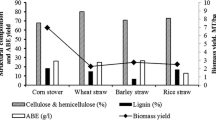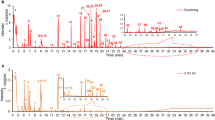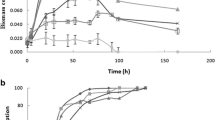Abstract
Biomass degradation compounds significantly inhibit biochemical conversion of biomass prehydrolysates to biofuels and chemicals, such as lactic acid. To characterize the structure-activity relationship of carbonyl inhibition on lactic acid fermentation, we examined effects of eight carbonyl compounds (furfural, 5-hydroxymethyl furfural, vanillin, syringaldehyde, 4-hydroxybenzaldehyde, phthalaldehyde, benzoic acid, and pyrogallol aldehyde) and creosol on lactic acid production by Lactobacillus delbrueckii. Pyrogallol aldehyde reduced the cell growth rate by 35 % at 1.0 mM and inhibited lactic acid production completely at 2.0 mM. By correlating the molecular descriptors to the inhibition constants in lactic acid fermentation, we found a good relationship between the hydrophobicity (Log P) of aldehydes and their inhibition constants in fermentation. The inhibitory effect of carbonyl inhibitors appeared to correlate with their thiol reactivity as well. In addition, we found that H2O2 detoxified pyrogallol aldehyde and phthalaldehyde inhibitory activity. H2O2 detoxification was applied to real biomass prehydrolysates in lactic acid fermentation.






Similar content being viewed by others
References
Boguta, A. M., Bringel, F., Martinussen, J. and Jensen, P. R. (2014). Screening of lactic acid bacteria for their potential as microbial cell factories for bioconversion of lignocellulosic feedstocks. Microb Cell Fact, 13
Chen, S. F., Mowery, R. A., Castleberry, V. A., van Walsum, G. P., & Chambliss, C. K. (2006). High-performance liquid chromatography method for simultaneous determination of aliphatic acid, aromatic acid and neutral degradation products in biomass pretreatment hydrolysates. Journal of Chromatography A, 1104, 54–61.
Nichols, N. N., Sharma, L. N., Mowery, R. A., Chambliss, C. K., van Walsum, G. P., Dien, B. S., & Iten, L. B. (2008). Fungal metabolism of fermentation inhibitors present in corn stover dilute acid hydrolysate. Enzyme and Microbial Technology, 42, 624–630.
Olsson, L., & HahnHagerdal, B. (1996). Fermentation of lignocellulosic hydrolysates for ethanol production. Enzyme and Microbial Technology, 18, 312–331.
Cao, D. X., Tu, M. B., **e, R., Li, J., Wu, Y. N., & Adhikari, S. (2014). Inhibitory activity of carbonyl compounds on alcoholic fermentation by saccharomyces cerevisiae. Journal of Agricultural and Food Chemistry, 62, 918–926.
Franden, M. A., Pilath, H. M., Mohagheghi, A., Pienkos, P. T., and Zhang, M. (2013). Inhibition of growth of Zymomonas mobilis by model compounds found in lignocellulosic hydrolysates. Biotechnol Biofuels, 6
Zaldivar, J., & Ingram, L. O. (1999). Effect of organic acids on the growth and fermentation of ethanologenic Escherichia coli LY01. Biotechnology and Bioengineering, 66, 203–210.
Zaldivar, J., Martinez, A., & Ingram, L. O. (1999). Effect of selected aldehydes on the growth and fermentation of ethanologenic Escherichia coli. Biotechnology and Bioengineering, 65, 24–33.
Zaldivar, J., Martinez, A., & Ingram, L. O. (2000). Effect of alcohol compounds found in hemicellulose hydrolysate on the growth and fermentation of ethanologenic Escherichia coli. Biotechnology and Bioengineering, 68, 524–530.
Larsson, S., Quintana-Sainz, A., Reimann, A., Nilvebrant, N. O., & Jonsson, L. J. (2000). Influence of lignocellulose-derived aromatic compounds on oxygen-limited growth and ethanolic fermentation by Saccharomyces cerevisiae. Applied Biochemistry and Biotechnology, 84–6, 617–632.
Chan, K., & O’Brien, P. J. (2008). Structure-activity relationships for hepatocyte toxicity and electrophilic reactivity of alpha, beta-unsaturated esters, acrylates and methacrylates. Journal of Applied Toxicology, 28, 1004–1015.
Schultz, T. W., Yarbrough, J. W., & Johnson, E. L. (2005). Structure-activity relationships for reactivity of carbonyl-containing compounds with glutathione. Sar and Qsar in Environmental Research, 16, 313–322.
Schwobel, J. A. H., Wondrousch, D., Koleva, Y. K., Madden, J. C., Cronin, M. T. D., & Schuurmann, G. (2010). Prediction of Michael-type acceptor reactivity toward glutathione. Chemical Research in Toxicology, 23, 1576–1585.
Schwobel, J. A. H., Koleva, Y. K., Enoch, S. J., Bajot, F., Hewitt, M., Madden, J. C., Roberts, D. W., Schutz, T. W., & Cronin, M. T. D. (2011). Measurement and estimation of electrophilic reactivity for predictive toxicology. Chemistry Review, 111, 2562–2596.
Zhang, D. X., Ong, Y. L., Li, Z., & Wu, J. C. (2013). Biological detoxification of furfural and 5-hydroxyl methyl furfural in hydrolysate of oil palm empty fruit bunch by Enterobacter sp FDS8. Biochemical Engineering Journal, 72, 77–82.
Shuler, M. L., & Kargi, F. (2002). Bioprocess engineering (2nd ed.). Upper Saddle River: Prentice Hall.
Ling, L. S., Mohamad, R., Rahim, R. A., Wan, H. Y., & Bin Ariff, A. (2006). Improved production of live cells of Lactobacillus rhamnosus by continuous cultivation using glucose-yeast extract medium. Journal of Microbiology, 44, 439–446.
Bohme, A., Thaens, D., Paschke, A., & Schuurmann, G. (2009). Kinetic glutathione chemoassay to quantify thiol reactivity of organic electrophiles-application to alpha, beta-unsaturated ketones, acrylates, and propiolates. Chemical Research in Toxicology, 22, 742–750.
Freidig, A. P., Verhaar, H. J. M., & Hermens, J. L. M. (1999). Quantitative structure-property relationships for the chemical reactivity of acrylates and methacrylates. Environmental Toxicology and Chemistry, 18, 1133–1139.
Parr, R. G., Von Szentpaly, L., & Liu, S. B. (1999). Electrophilicity index. Journal of the American Chemical Society, 121, 1922–1924.
**e, R., Tu, M. B., Wu, Y. N., & Taylor, S. (2012). Reducing sugars facilitated carbonyl condensation in detoxification of carbonyl aldehyde model compounds for bioethanol fermentation. RSC Advances, 2, 7699–7707.
Ezeji, T., Qureshi, N., & Blaschek, H. P. (2007). Butanol production from agricultural residues: impact of degradation products on Clostridium beijerinckii growth and butanol fermentation. Biotechnology and Bioengineering, 97, 1460–1469.
Palmqvist, E., Almeida, J. S., & Hahn-Hagerdal, B. (1999). Influence of furfural on anaerobic glycolytic kinetics of Saccharomyces cerevisiae in batch culture. Biotechnology and Bioengineering, 62, 447–454.
Wahlbom, C. F., & Hahn-Hagerdal, B. (2002). Furfural, 5-hydroxymethyl furfural, and acetoin act as external electron acceptors during anaerobic fermentation of xylose in recombinant Saccharomyces cerevisiae. Biotechnology and Bioengineering, 78, 172–178.
Taherzadeh, M. J., Niklasson, C., & Liden, G. (1997). Acetic acid—friend or foe in anaerobic batch conversion of glucose to ethanol by Saccharomyces cerevisiae? Chemical Engineering Science, 52, 2653–2659.
Chan, K., Jensen, N., & O’Brien, P. J. (2008). Structure–activity relationships for thiol reactivity and rat or human hepatocyte toxicity induced by substituted p-benzoquinone compounds. Journal of Applied Toxicology, 28, 608–620.
Cronin, M. T. D., & Schultz, T. W. (1996). Structure-toxicity relationships for phenols to Tetrahymena pyriformis. Chemosphere, 32, 1453–1468.
Cronin, M. T. D., & Schultz, T. W. (2001). Development of quantitative structure-activity relationships for the toxicity of aromatic compounds to Tetrahymena pyriformis: comparative assessment of the methodologies. Chemical Research in Toxicology, 14, 1284–1295.
Klinke, H. B., Thomsen, A. B., & Ahring, B. K. (2004). Inhibition of ethanol-producing yeast and bacteria by degradation products produced during pre-treatment of biomass. Applied Microbiology and Biotechnology, 66, 10–26.
Larsson, S., Reimann, A., Nilvebrant, N. O., & Jonsson, L. J. (1999). Comparison of different methods for the detoxification of lignocellulose hydrolyzates of spruce. Applied Biochemistry and Biotechnology, 77–9, 91–103.
Palmqvist, E., & Hahn-Hagerdal, B. (2000). Fermentation of lignocellulosic hydrolysates. II: inhibitors and mechanisms of inhibition. Bioprocess Technology, 74, 25–33.
Leonard, R. H., & Hajny, G. J. (1945). Fermentation of wood sugars to ethyl alcohol. Industrial and Engineering Chemistry, 37, 390–395.
Hodge, D. B., Andersson, C., Berglund, K. A., & Rova, U. (2009). Detoxification requirements for bioconversion of softwood dilute acid hydrolysates to succinic acid. Enzyme and Microbial Technology, 44, 309–316.
Lee, J. M., Venditti, R. A., Jameel, H., & Kenealy, W. R. (2011). Detoxification of woody hydrolysates with activated carbon for bioconversion to ethanol by the thermophilic anaerobic bacterium Thermoanaerobacterium saccharolyticum. Biomass and Bioenergy, 35, 626–636.
Acknowledgments
The authors appreciate the financial support of this study, partially, by grants from the Auburn Univeristy (IGP and AAES) and by the National Science Foundation (NSF-CBET 1254899).
Author information
Authors and Affiliations
Corresponding author
Additional information
**g Li and Caiqing Zhu contributed equally to this work.
Rights and permissions
About this article
Cite this article
Li, J., Zhu, C., Tu, M. et al. Effect of Carbonyl Inhibitors and Their H2O2 Detoxification on Lactic Acid Fermentation. Appl Biochem Biotechnol 175, 3657–3672 (2015). https://doi.org/10.1007/s12010-015-1533-2
Received:
Accepted:
Published:
Issue Date:
DOI: https://doi.org/10.1007/s12010-015-1533-2




